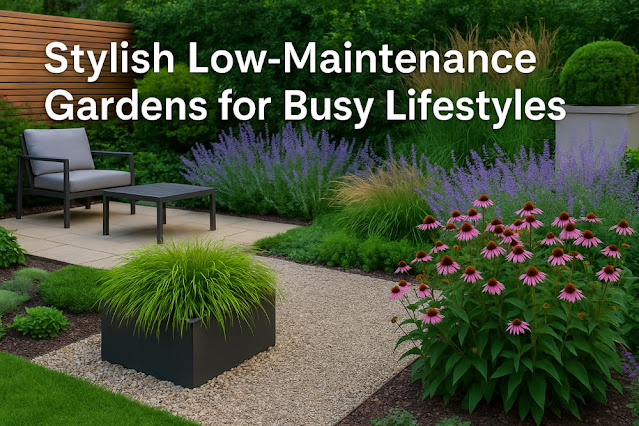In today’s fast-paced world, where every minute counts, many of us still dream of a lush, private outdoor retreat. But crafting and maintaining a garden can feel overwhelming when time is tight. Enter the stylish, low‑maintenance gardens — a harmonious blend of beauty and ease, designed to thrive with minimal care. These gardens aren’t just practical; they’re becoming essential as modern homeowners balance careers, family, and wellness. From water-saving landscapes to eco-friendly native plantings, this guide explores expert-approved ideas, trends, and real-world examples to help busy people cultivate breathtaking outdoor spaces that keep their hectic lives in mind.
Stylish Low-Maintenance Gardens for Busy Lifestyles
1. Plan with Purpose: Layout & Hardscaping
A well-organized garden reduces chores and elevates style. Start by defining distinct zones—dining areas, lounging spots, paths—separated by durable hardscape elements like gravel, flagstone, or decking. These add structure and curb appeal while eliminating weeding, mowing, and soil work.
- Gravel & paved paths are hands-free, drain well, and don’t need mowing.
- Resin stone patios or minimalist driveways provide cohesion and low upkeep year-round, as seen in project highlights from Exeter and Buckinghamshire.
2. Choose the Right Plants: Resilient & Region-Smart
Plant selection is key. Favor perennials, native species, and drought-hardy shrubs that flourish in local conditions and need little attention.
- Xeriscaping, using drought-tolerant and native plants, can cut water use by 30–60% compared to traditional lawns.
- Native plantings not only thrive naturally but boost biodiversity by attracting pollinators and wildlife.
- Easy-to-grow examples include lavenders, ornamental grasses, sedges, and hardier shrubs like boxwood or hydrangea .
3. Go Big on Containers & Community Plantings
- Large containers or raised beds hold moisture longer and require less frequent watering than small pots or lawn areas.
- Community planting—dense layered plantings of ground covers, perennials, and shrubs—acts as 'living mulch', suppressing weeds and reducing maintenance.
- Even a capsule selection of perennials like coral bells shows season-after-season resilience and visual appeal with minimal effort.
4. Embrace Naturalistic & Wabi‑Sabi Styles
Modern garden trends include letting nature take center stage.
- Wabi-sabi gardening, which celebrates imperfection, has grown popular, with interest reportedly doubling this year.
- Prairie-style designs, using low native grasses and wildflowers, need just a spring trim and provide rich seasonal texture and wildlife habitat.
- Letting seedheads and leaf litter remain through winter benefits soil health and attracts wildlife.
5. Eco-Benefits & Sustainability
These gardens aren’t just low work—they’re better for the planet.
- Reducing turf lawns cuts water usage substantially, as much as 18–60% in some studies.
- Xeriscaping reduces the need for fertilizers, pesticides, and runoff, and cuts both construction and maintenance costs by roughly 55%
- Strategic planting also reduces energy bills: trees and shrubs can lower heating and cooling needs by up to 25%
6. Case Studies & Expert Insights
Kelly Norris’s Iowa Prairie Garden
Horticulturist Kelly Norris transformed his front lawn into a native prairie garden that now requires only a spring mow and path tidying. “Everything has grown in and feels as comfy as a well‑worn sweater,” Norris says. The design attracts many pollinators and thrives on rainwater with zero fertilizer.
Geoff Stone Banks's Accessible Makeover
Raised pond margins, succulents, leveled walkways, and drip irrigation are some of the ways landscape designer Geoff Stone banks redesigned his Bishopstone garden for aging. This update cut maintenance dramatically while raising over £177,000 for charity.
7. Maintenance Tips for the Time-Strapped
- Weed lightly but regularly: quick sessions before weeds take hold.
- Mulch annually with organic material to lock in moisture and suppress weeds.
- Let nature lead: retain seedheads for habitat and soil nutrition, and avoid over-pruning.
- Water intentionally: focus irrigation on container and young plants; established native beds rely on rainfall.
- Design smart borders: straight edge on any remaining lawn makes mowing faster and cleaner.
Conclusion
Low-maintenance gardens provide a welcome blend of aesthetic appeal, tranquility, and environmental benefits for people with hectic schedules. 3. The secret is careful design and plant selection, regardless of whether you choose wabi-sabi wildscapes, hardy natives, container plants, or eye-catching hardscape paths. Data shows water savings of up to 60%, maintenance cost cuts around 55%, and improved energy efficiency—evidence that these gardens are as sensible as they are beautiful.
The experts confirm it: with thoughtful design, you can leave the mower behind, attract wildlife, reduce costs, and enjoy a peaceful green haven—all without dedicating weekend after weekend to gardening. Start with one focused zone, pick a low-upkeep plant palette, and let nature do the rest. Your stylish, effortless garden awaits.







